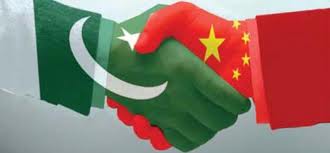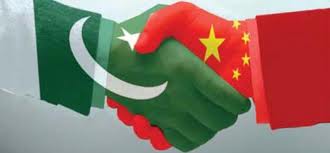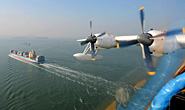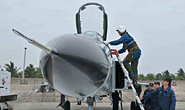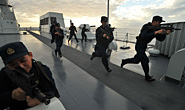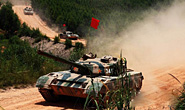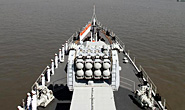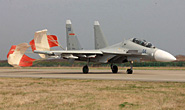From the The Hindu
The deal marks the depth of a strategic alliance between Beijing and Islamabad. Some reports suggest that Pakistan is actually seeking 150 J-10 fighter jets, which go by Chengdu Jian-10 in China and F-10 in Pakistan, for a sum of $6 billion (The Hindu, November 11). The Pakistani government, however, dismisses such reports as inflated (Financial Times, November 10). Although Pakistan has not yet made the deal public, its prime minister, Yousaf Raza Gilani, on November 23, confirmed that “his country is in talks with China for securing the J-10s” [1]. Pakistan turned to China for these aircraft in 2006 after it failed to secure the F-16s from the United States (Dawn, May 1, 2006). General Pervez Musharraf, Pakistan’s former military ruler, who negotiated the deal during his visit to China in 2006, is the real architect of this grand sale (The Hindu, November 11).
The J-10s are China’s third generation fighter aircraft that it has indigenously developed (The Hindu, November 11) and manufactured at the Chengdu Aircraft Industry (CAI). Some observers, however, believe that J-10s are China’s fourth generation aircraft. “This aircraft is a cousin to the Israeli Lavi (upon which it is based) and roughly equivalent in capabilities to the U.S. F-16C flown by several air forces around the world” (See “China’s Re-emergence as an Arms Dealer: The Return of the King?” China Brief, July 9). The J-10s started development in the mid-1980s and finally entered production for the People’s Liberation Army Air Force (PLAAF) about three or four years ago. Aviation experts rank them below the F-16s, the Swedish Gripen and other smaller combat aircraft (China Brief, July 9). According to a report in The Hindu (November 11), China is working on developing its fourth generation fighter jets as well. The United States, The Hindu report further claims, is the only country that possesses a fourth generation combat aircraft—the F-22s. Yet aviation experts believe the F-22s are fifth generation fighter jets. Chinese Deputy Commander of the PLAAF General He Weirong claimed that “China would operationalize its very own fourth generation aircraft in the next eight or ten years” (The Hindu, November 11). The Chinese official further claimed that the fourth generation planes would “match or exceed the capacity of similar jets in existence today” (The Hindu, November 11).
In anticipation, China is also training Pakistani fighter pilots for flying the fourth generation combat aircraft. On January 16, it delivered eight Karakoram K-8P trainer jets to Pakistan for this purpose. According to an official statement, the K-8P jets had enhanced the basic training of PAF pilots and provided a “potent platform for their smooth transition to more challenging fourth generation fighter aircraft” (The Asian Defence, January 16). The K-8P is an advanced trainer jet that has been jointly developed by China and Pakistan. It is already in service at the PAF Academy. At the handing-over ceremony for the K-8Ps, a visiting Chinese delegation as well as high-ranking PAF officers were in attendance.
China’s sale of the J-10 fighters to Pakistan, however, signals the depth of its strategic alliance with Pakistan. Pakistan will be the first country to receive the most advanced Chinese aircraft, which speaks volumes to Chinese faith in its strategic partnership with Pakistan. Defense analysts, however, believe that the sale sends an important message to the world that China’s “defense capability is growing rapidly” (Financial Times, November 10). China-Pakistan military relations spanned over 43 years, starting in 1966 when China provided Pakistan with F-6s, which were followed by the successive supply of such aircraft as FT5, A5, F-7P, F-7PG and K-8 (Jang, November 22).
These relations continue to grow with high-level exchanges in the defense sector. As recently as October of this year, Chinese Vice-Minister Chen Qiufa, administrator of China’s State Administration for Science, Technology & Industry for National Defense (SASTIND), led a delegation of Chinese defense-companies to Pakistan. He called on Prime Minister Gilani and discussed cooperation in the JF-17 Thunder Project, Al Khalid tank, F-22 frigates, Airborne Warning and Control System (AWACS), and aircraft and naval ships (APP, October 17). The Chinese delegation included representatives from China’s missile technology firm Poly Technologies as well as Aviation Industries Corp. of China, China Shipbuilding Industry Corporation, China Electronics Technology Group and China North Industry Corporation.
Although there is a proliferation of joint defense projects between China and Pakistan, their collaboration in aviation industry has peaked at the turn of the millennium. The mainstay of their joint defense production is the Pakistan Aeronautical Complex (PAC) in Kamra (Punjab), which services, assembles and manufactures fighter and trainer aircraft. The PAC is rated as the world’s third largest assembly plant. Initially, it was founded with Chinese assistance to rebuild Chinese aircraft in the PAF fleet, which included Shenyang F-6 (now retired), Nanchang A-5, F-7 combat aircraft, Shenyang FT-5 and FT-6 Jet trainer aircraft. The PAC also houses the Kamra Radar and Avionics Factory (KARF), which is meant to assemble and overhaul airborne as well as ground-based radar systems, electronics, and avionics. The KARF, which is ISO-9002 certified, has upgraded the PAF Chengdu F-7P interceptor fleet. Over time, the PAC has expanded its operation into aircraft manufacturing, and built a specialized manufacturing unit in the 1980s: The Aircraft Manufacturing Factory (AMF). The AMF got noticed in the region when it partnered with the Hongdu Aviation Industry Group of China to design, develop and coproduce the K-8 Karakoram (Hongdu JL-8), which is an advanced jet trainer. The AMF’s flagship project, however, is the Sino-Pakistani joint production and manufacture of the JF-17 Thunder aircraft, which it is producing with the Chengdu Aircraft Industry (CAI).
JF-17 Thunder Makes Over the PAF
In recent history, China and Pakistan set out for the joint production of JF-17 combat aircraft that both countries consider a substitute for U.S. F-16s. Pakistan’s indigenous manufacture of the first JF-17 (which goes by FC-1 in China) came to fruition on November 23, when Pakistan Aeronautical Complex (PAC), an arm of the Pakistan Air Force, turned it over to the PAF to the chants of “Long Live Pak-China Friendship” (The News International, November 24).
Pakistan’s Prime Minister, Pakistan Chief of Army Staff and Chinese Ambassador to Pakistan, Lou Zhaohui, were among the dignitaries who attended the handing-over ceremony. Chinese Ambassador Zhaohui, speaking on the occasion, told his audience: “China wants to further broaden the defense cooperation with Pakistan” (Jang, November 23). The PAF already has 10 JF-17s, which were produced in China, in its fleet. The JF-17 project began in 1992, under which China agreed to transfer technology for the aircraft’s joint production. The project was hampered in 1999, when Pakistan came under proliferation sanctions. It gained momentum in 2001.
On September 3, 2003, its prototype, which was manufactured in China, conducted the first test flight. The PAF claims that the JF-17s, with a glass cockpit and modern avionics, are comparable to any fighter plane (Jang, November 23). It is a lightweight combat jet, fitted with turbofan engine, advanced flight control, and the most advanced weapons delivery system. As a supersonic plane, its speed is 1.6 times the speed of its sound, and its ability to refuel midair makes it a “stand-out” (Jang, November 23). Pakistan intends to raise a squadron of JF-17s by 2010. The Chief of Air Staff of the PAF told a newspaper that JF-17s would help “replace the existing fleet of the PAF comprising F-7s, A-5s and all Mirage aircraft” (The News International, November 8). Eventually, Pakistan will have 350 JF-17s that will completely replace its ageing fleet.
Pakistan also plans to export these aircraft to developing countries for which, it says, orders have already started pouring in (Jang, November 22). China and Pakistan anticipate an annual export of 40 JF-17s to Asian, African and Middle Eastern nations [2]. At $25 million apiece, the export of 40 aircraft will fetch them $1 billion per year. There are estimates that Asia will purchase 1,000 to 1,500 aircraft over the next 15 years. In this Sino-Pakistani joint venture, Pakistan will have 58 percent of shares, while China will have 42 percent (The News International, November 25). Besides defense aviation, China and Pakistan are closely collaborating on the joint production of naval ships as well.
Chinese Frigates for the Pakistan Navy
China and Pakistan worked out a $750 million loan to help Pakistan build four F-22P frigates (The News International, September 16, 2004). In 2004, Pakistan negotiated this non-commercial (i.e. low-cost) loan with China for the joint manufacture of naval ships. China and Pakistan have since moved fast to begin work on this project. They have now expanded the original deal to build eight F22P frigates respectively at Hudong Zhonghua shipyard in Shanghai, China, and Karachi shipyard and Engineering Works (KSEW), Pakistan. The manufacturing cost of each F22P Frigate, which is an improved version of China’s original Type 053H3 Frigate, is $175 million. At this rate, the cost of eight frigates will run at about $1.4 billion.
The first Chinese-built F-22 frigate, named PNS Zulfiqar (Arabic for sword), was delivered to Pakistan on July 30 (The Nation, July 31). A month later, the ship was formally commissioned in the Pakistan Navy fleet in September. Soon after its arrival in July, the ship participated in the Pakistan Navy’s SeaSpark exercises. Of the original four frigates, three were to be built in China and one in Pakistan (Asia Times, July 11, 2007). After the delivery of PNS Zulfiqar, the remaining two ships that are being built in China are expected to be commissioned in the Pakistan Navy fleet by 2010. The fourth ship being built in Pakistan’s Karachi shipyard will be ready by 2013 (Asia Times, July 11, 2007).
The Pakistan Navy describes the F-22P frigate as a Sword Class ship that is equipped with long-range surface-to-surface missiles (SSM) and surface-to-air missiles (SAM), depth charges, torpedoes, the latest 76mm guns, a close-in-weapons system (CIWS), sensors, electronic warfare and an advanced command and control system (The Nation, July 31). The ship has a displacement of 3,000 tons and carries anti-submarine Z9EC helicopters. China has already delivered the first batch of two such helicopters to Pakistan. Although the Pakistan Navy has Sea-King helicopters for anti-submarine operations, it is now acquiring Chinese Z9ECs to enhance its operational capabilities (The Nation, July 31). In addition to building eight frigates, the Sino-Pakistan defense deal includes the upgrading of the Karachi dockyard for indigenous production of a modern surface fleet. The frigates deal is the first of its kind between China and Pakistan, which forges their two navies into a high-level collaboration for boosting their surface fleet.
Conclusion
At the turn of the millennium, China and Pakistan have diversified their defense trade into joint defense production. They have since been collaborating on the production of most advanced weapons systems, such as the JF-17s combat aircraft and F-22P Frigates. Pakistan will receive the transfer of technology for the J-10s as well. China recognizes that Pakistan is rich with human capital in the high-tech defense industry, which serves as a magnet for its investment. Both China and Pakistan look to capture wider defense export markets in Asia, Africa and the Middle East. At the same time, their growing cooperation in aviation and naval defense systems signals an important shift in Pakistan’s military doctrine that traditionally favored Army (especially ground forces) over its sister services—Navy and Air Force. In the region’s changing strategic environment, in which China has growing stakes, Pakistan has come to recognize the critical importance of air and naval defense. The China-Pakistan collaboration in aviation and naval defense amply embodies this recognition.
Notes
1. “NRO beneficiaries will be held to account.” Daily Intekhab, dailydailyintekhab.com.pk/news/news10.gif. 2. Tarique Niazi, “China-Pakistan Relations: Past, Present and Future,” A presentation made at the Woodrow Wilson International Center for Scholars on January 29, 2009.
Publication: China Brief Volume: 9 Issue: 25
By: Tarique Niazi
CHENGDU J-10
Multi-role fighter
The J-10 multi-role fighter is the first Chinese-developed combat aircraft that approaches Western fighters in terms of performance and capabilities.Development of the J-10 began in 1988. It was intended to counter threat posed by the Soviet forth-generation fighters – the MiG-29 and Su-27. The J-10 was initially planned as an air-superiority fighter, however collapse of the Soviet Union and changing requirements shifted the development towards a multi-role fighter. Aircraft made it’s maiden flight in 1998. The whole project was kept under high secrecy. It is worth mentioning, that the first photos of the J-10 came out only 3-4 years after the first flight. Some sources claim that it was influenced by the IAI Lavi. The J-10 multi-role fighter entered service with Chinese air force in 2004, however it was first publicly revealed only in 2006. Currently around 240 of these aircraft are in service. It is estimated that 300 fighter of this type will be required for Chinese air force and possibly naval aviation too. A number of countries, including Indonesia, Iran, Pakistan and Thailand shown interest in purchasing this aircraft.The J-10 has a single engine. The first batch of about 50 aircraft is powered by Russian AL-31FN turbofan engines. This batch was delivered to Chinese air force between 2004 and 2006. An indigenous Taihang turbofan is under development.The J-10 has beyond visual range air combat and surface attack capabilities. Aircraft has 11 external hardpoints for a range of weapons. Alternatively it can carry target acquisition, navigation pods or auxiliary fuel tanks. It is worth mentioning that the J-10 has an in-flight refueling capability.The main armament on the air-superiority missions are the PL-12 medium-range active radar-homing air-to-air missiles. For close ranges it carries the PL-8 infrared-homing missiles. For surface attack role the J-10 carries up to six 500-kg laser-guided bombs, free-fall bombs or 90-mm unoperated rocket pods. Aircraft is also completed with a single-barrel 23-mm cannon.The J-10 is fitted with an indigenously designed pulse-doppler fire control radar. It is capable of tracking 10 targets simultaneously and attacking 4 of them. Estimated maximum detection range is 100 km. Aircraft is fitted with a fly-by-wire system.A two-seat variant, the J-10S fighter-trainer, is available. It is identical to the single-seat variant, but has a stretched fuselage to accommodate second pilot seat. The J-10S can be used for pilot training or as a standard fighter. This aircraft maid it’s maiden flight in 2003.VariantsJ-10B multi-role fighter, with improved airframe and avionics. It is likely to become a standard production model.
|
|||||||||||||||||||||||||||||||||||||||||||

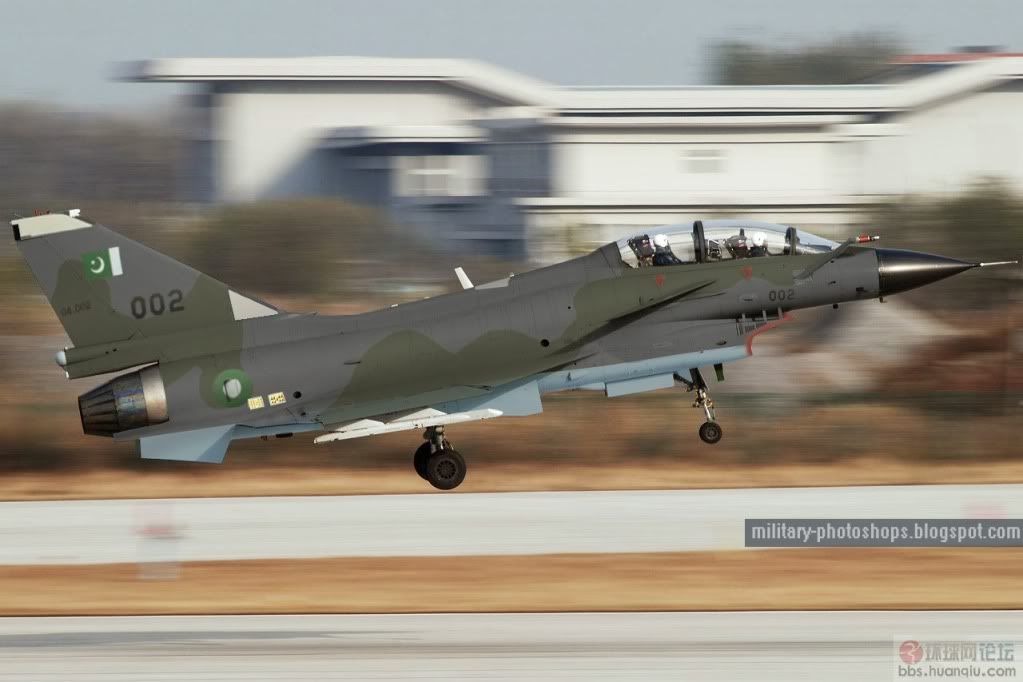



 Hangor (Daphne) Submarine
Hangor (Daphne) Submarine Hashmat (Agosta 70) Submarine
Hashmat (Agosta 70) Submarine Khalid (Agosta 90B) Submarine
Khalid (Agosta 90B) Submarine


